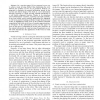Free Online Productivity Tools
i2Speak
i2Symbol
i2OCR
iTex2Img
iWeb2Print
iWeb2Shot
i2Type
iPdf2Split
iPdf2Merge
i2Bopomofo
i2Arabic
i2Style
i2Image
i2PDF
iLatex2Rtf
Sci2ools
ICRA
2010
IEEE
2010
IEEE
Improving mutual information-based visual servoing
— In a previous paper [3], we proposed a new way to achieve visual servoing. Rather than minimizing the error between the position of two set of geometric features, we proposed to maximize the mutual information shared by the current and desired images. This leads to a new information theoretic approach to visual servoing. Mutual information is a well known alignment function. Thanks to its robustness toward illumination variations, occlusions and multi modality, it has been widely used in medical applications for alignment as well as in general tracking problems. Despite those previous works, no highlight has been given on the problem of Hessian computation that yields, in the case of common approximations, to divergence of the optimization process. In this paper we focus on the need of computing the second order derivative of the mutual information in visual servoing. Experiments on a 6 dof robot demonstrates the significance of this work on visual servoing tasks.
| Added | 26 Jan 2011 |
| Updated | 26 Jan 2011 |
| Type | Journal |
| Year | 2010 |
| Where | ICRA |
| Authors | Amaury Dame, Éric Marchand |
Comments (0)

